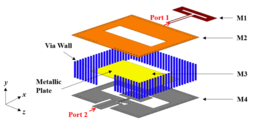Dual Band, Dual Polarized, Millimeter-Wave Antenna Array for 5G Smart Phones
TECHNOLOGY NUMBER: 2020-221
Tags:

OVERVIEW
A dual-band, dual-polarization millimeter wave antenna array- Designed to be planar, compact and easily integrated with other chips
- Useful for mobile devices, transportation, and the internet of things
BACKGROUND
The overwhelming demand for higher data rate, bandwidth and capacity has been driving the transition from the current 4G mobile communication to the 5th generation (5G). In order to facilitate the transition into 5G, advances in antenna technology are required to improve inadequate signals and poor bandwidth. Millimeter wave antennas have therefore become crucial components in 5G mobile systems since they enable the high-speed data transmission necessary for next-generation wireless communication. Antennas that operate in the millimeter wave frequency range provide a larger bandwidth for data transfer than the lower frequencies used in previous cellular systems. The capabilities of these new antennas enable functionalities such as augmented and virtual reality, autonomous vehicles, and smart cities. So, given their importance, a need exists for technologies that optimize millimeter wave antenna capabilities.
INNOVATION
Researchers have created a dual-band, dual-polarization millimeter wave antenna array that can simultaneously cover the 28 GHz to 38 GHz frequency bands and whose radiation beam can be manipulated for optimal control. Planar antennas can easily be integrated with a cell phone printed circuit board and directly connected to integrated circuit chips while meeting the goal of creating a compact device size. As such, this design is planar, compact and easily integrated with other chips for a working system. Dual-polarization allows for diversity in signal reception, thereby improving the system's robustness against signal fading and interference. Additionally, the dual-polarization functionality minimizes losses due to polarization mismatch errors during signal transmission and reception. Finally, the improved spatial resolution and accuracy supports advanced application such as mmWave imaging and localization. The overall advantages inherent in this new approach will broadly impact wireless communication industries including mobile devices, the internet of things, and transportation.
PATENT APPLICATION
Number: US20210359413
-
expand_more mode_edit Inventor (2)Kamal SarabandiMenglou Rao
-
expand_more library_books References (1)
- Rao, M, and Sarabandi, K. , A Compact Wideband Dual-polarized Millimeter Wave Antenna for 5G Smartphones. 2019 IEEE International Symposium on Antennas and Propagation and USNC-URSI Radio Science Meeting, 2019, pp. 697-69810.1109/APUSNCURSINRSM.2019.8889070
-
expand_more cloud_download Supporting documents (1)Product brochureDual Band, Dual Polarized, Millimeter-Wave Antenna Array for 5G Smart Phones.pdf